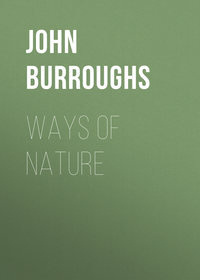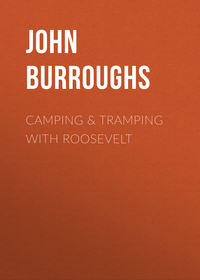 полная версия
полная версияRiverby
There is something in most of us that welcomes a departure from the ordinary routine of natural causes; we like to believe that the impossible happens; we like to see the marvelous and mysterious crop out of ordinary occurrences. We like to believe, for instance, that snakes can charm their prey; can exert some mysterious influence over bird or beast at a distance of many feet, which deprives it of power to escape. But there is probably little truth in this popular notion. Fear often paralyzes, and doubtless this is the whole secret of the power of snakes and cats to charm their prey. It is what is called a subjective phenomenon; the victim is fascinated or spellbound by the sudden and near appearance of its enemy. A sportsman, in whose veracity I have full confidence, told me that his pointer dog had several times worked up to a woodcock or partridge and seized it in his mouth. Of course the dog brought no mysterious power to bear upon the bird. He could hardly have seen the bird till he came plump upon it; he was wholly intent upon unraveling its trail. The bird, in watching the eager motions and the gradual approach of the dog, must have been thrown into such a state of fear or consternation as to quite paralyze its powers, and suffered the dog to pick it up. In the case of snakes, they doubtless in most instances approach and seize their prey unawares. I have seen a little snake in the woods pursue and overtake a lizard that was trying to escape from it. There was no attempt at charming; superior speed alone gave the victory to the snake. I have known a red squirrel to be caught and swallowed by a black snake, but I have no belief that the squirrel was charmed; it was more probably seized from some ambush.
One can hardly understand how a mouse can be caught by a hawk except upon the theory that the mouse is suddenly paralyzed by fear. The meadow mouse when exposed to view is very wary and quick in its movements; it is nibbling grass in the meadow bottom, or clearing its runway, or shaping its nest, when the hawk poises on wing high in the air above it. When the hawk discovers its victim, it descends with extended talons to the earth and seizes it. It does not drop like a bolt from heaven; its descent, on the contrary, is quite deliberate, and must be attended by a sound of rushing wings that ought to reach the mouse's ear, if the form escapes its eye.
There is doubtless just as much "charming" in this case as in any other, or when a fish hawk falls through the air and seizes a fish near the surface in perfectly clear water – what hinders the fish from seeing and avoiding its enemy? Apparently nothing; apparently it allows itself to be seized. Every fisherman knows how alert most fish are, how quickly they discover him and dart away, even when he is immediately above them. All I contend for is that the snake, the cat, the hawk, does not exert some mysterious power over its prey, but that its prey in many cases loses its power to escape through fear. It is said that a stuffed snake's skin will charm a bird as well as the live snake.
I came near reaching a hasty conclusion the other day with regard to a chickadee's nest. The nest is in a small cavity in the limb of a pear-tree near my study, and the birds and I are on very friendly terms. As the nest of a pair of chickadees had been broken up here a few seasons ago by a mouse or squirrel, I was apprehensive lest this nest share the same fate. Hence when, one morning, the birds were missing, and I found on inspection what appeared to be the hair of some small animal adhering to the edges of the hole that leads to the nest, I concluded that the birds had been cleaned out again. Later in the day I examined the supposed hair with my pocket glass, and found it was not hair, but some vegetable fibre. My next conclusion was that the birds had not been molested, but that they were furnishing their apartment, and some of the material had stuck to the door jambs. This proved to be the correct inference. The chickadee makes a little felt-like mat or carpet with which it covers the bottom of the nest-cavity. A day or two later, in my vineyard near by, I found where a piece of heavy twine that held a young grapevine to a stake had been pulled down to the ground and picked and beaten, and parts of it reduced to its original tow. Here, doubtless, the birds had got some of their carpeting material.
I recently read in a work on ornithology that the rings of small holes which we see in the trunks and limbs of perfectly sound apple-trees are made by woodpeckers in search of grubs and insects. This is a hasty inference. These holes are made by woodpeckers, but the food they obtain at the bottom of them is not the flesh of worm or insect, but the flesh of the apple-tree – the soft, milky inner bark. The same writer says these holes are not hurtful to the tree, but conducive to its health. Yet I have seen the limbs of large apple-trees nearly killed by being encompassed by numerous rings of large, deep holes made by the yellow-bellied woodpecker. This bird drills holes in the sugar maple in the spring for the sap. I have known him to spend the greater part of a bright March day on the sunny side of a maple, indulging in a tipple of maple sap every four or five minutes. As fast as his well holes filled up he would sip them dry.
A lady told me that a woodpecker drilled holes in the boards that form the eaves of her house, for the grubs of the carpenter bumblebee. This also seemed to me a hasty conclusion, because the woodpeckers made holes so large that the next season the bluebirds nested there. The woodpeckers were probably drilling for a place to nest. A large ice-house stands on the river bank near me, and every season the man in charge has to shoot or drive away the high-holes that cut numerous openings through the outer sheathing of hemlock boards into the spaces filled with sawdust, where they find the digging easy and a nesting-place safe and snug.
My neighbor caught a small hawk in his shad-net, and therefore concluded the hawk ate fish. He put him in a cage, and offered him fragments of shad. The little hawk was probably in pursuit of a bird which took refuge under the net as it hung upon the drying-poles; or he may have swooped down upon the net in the spirit of pure bluster and bravado, and thus came to grief in a hurry. The fine, strong threads of the net defied his murderous beak and talons. He was engulfed as completely as is a fly in a spider's web, and the more he struggled the more hopeless his case became. It was a pigeon hawk, and these little marauders are very saucy.
My neighbor says that in the city of Brooklyn he has known kingbirds to nest in boxes like martins and bluebirds. I question this observation, though it may be true. The cousin of the kingbird, the great crested flycatcher, builds in cavities in trees, and its relative, the phœbe-bird, nests under bridges and hay-sheds. Hence there is this fact to start with in favor of my neighbor's observation.
But when a lady from Pennsylvania writes me that she has seen "swallows rolling and dabbling in the mud in early spring, their breasts so covered with it that it would take but little stretch of imagination to believe they had just emerged from the bottom of the pond beside which they were playing," I am more than skeptical. The lady has not seen straight. The swallows were not rolling in the mud; there was probably not a speck of mud upon their plumage, but a little upon their beaks and feet. The red of their breasts was their own proper color. They were building their nests, as my correspondent knew, but they did not carefully mix and knead the mud, as she thought they did; they had selected mortar already of the proper sort.
The careful observer is not long in learning that there is truth in the poet's remark, that "things are not what they seem." Everywhere on the surface of nature things seem one thing, and mean quite another. The hasty observer is misled by the seeming, and thus misses the real truth.
The little green snake that I saw among the "live-for-evers" the other day, how nearly it escaped detection by the close resemblance of its color to that of the plant! And when, a few days later, I saw one carelessly disposed across the top of the bending grass and daisies, but a few feet from where I sat, my eye again came near being baffled.
The little snake was probably lying in wait for some insect. Presently it slid gently down into the grass, moving so slowly as to escape any but the most watchful eye. After its head and a part of its body were upon the ground, its tail still pointed straight up and exactly resembled some fresh vegetable growth. The safeguard of this little snake is in his protective coloring; hence his movements are slower and more deliberate than those of the other snakes.
This simulation is very common in nature. Every creature has its enemy, and pretends to be that which it is not, in order to escape detection. The tree-frog pretends to be a piece of bark, or a lichen upon a tree; the wood frog is the color of the dry leaves upon which it hops, though when spawning in the little black pools and tarns in spring its color is very dark, like the element it inhabits.
One day, in my walk in the woods, I disturbed a whip-poor-will where she sat upon her eggs on the ground. When I returned to the spot some hours afterward, and tried to make out the bird upon her nest, my eye was baffled for some moments, so successful was she in pretending to be only a mottled stick or piece of fallen bark.
Only the most practiced eye can detect the partridge (ruffed grouse) when she sits or stands in full view upon the ground in the woods. How well she plays her part, rarely moving, till she suddenly bursts up before you, and is gone in a twinkling! How well her young are disciplined always to take their cue from her! Not one will stir till she gives the signal.
One day in my walk, as I paused on the side of a steep hill in the edge of the woods, my eye chanced to fall upon a partridge, sitting upon the leaves beside a stump scarcely three paces from me. "Can she have a nest there?" was my first thought. Then I remembered it was late in the summer, and she certainly could not be incubating. Then why is she sitting there in that exposed manner? Keeping my eye upon her, I took a step forward, when, quick as a flash, she sprang into the air and went humming away. At the same moment, all about me, almost from under my feet, her nearly grown young sprang up and went booming through the woods after her. Not one of them had moved or showed fear till their mother gave the word.
To observe Nature and know her secrets, one needs not only a sharp eye, but a steady and patient eye. You must look again and again, and not be misled by appearances. All the misinformation about the objects and phenomena of nature afloat among country people is the result of hasty and incomplete observation.
In parts of the country where wheat is grown there is quite a prevalent belief among the farmers that if the land is poor or neglected the wheat will turn into chess or cheat grass. Have they not seen it, have they not known the wheat to disappear entirely, and the chess to be there in its place?
But like so many strange notions that are current in the rural districts, this notion is the result of incomplete observation. The cheat grass was there all the while, feebler and inconspicuous, but biding its time; when the wheat failed and gave up possession of the soil, the grass sprang forward and took its place.
Nature always has a card to play in that way. There is no miracle nor case of spontaneous generation about the curious succession of forest trees – oak succeeding pine, or poplar succeeding birch or maple – if we could get at the facts. Nature only lets loose germs which the winds or the birds and animals have long since stored there, and which have only been waiting their opportunity to grow.
A great many people are sure there is such a creature as a glass snake, a snake which breaks up into pieces to escape its enemies, and then when danger is past gets itself together again and goes its way.
Not long since a man published an account in a scientific journal of a glass snake which he had encountered in a hay-field, and which, when he attempted to break its head, had broken itself up into five or six pieces. He carefully examined the pieces and found them of regular lengths of three or four inches, and that they dovetailed together by a nice and regular process. He left the fragments in the grass, and when he returned from dinner they were all gone. He therefore inferred the snake had reconstructed itself and traveled on. If he had waited to see this process, his observation would have been complete. On another occasion he cut one in two with his scythe, when the snake again made small change of itself. Again he went to his dinner just at the critical time, and when he returned the fragments of the reptile had disappeared.
This will not do. We must see the play out before we can report upon the last act.
There is, of course, a small basis of fact in the superstition of the glass snake. The creature is no snake at all, but a species of limbless lizard quite common in the West. And it has the curious power of voluntarily breaking itself up into regular pieces when disturbed, but it is only the tail which is so broken up; the body part remains intact. Break this up and the snake is dead. The tail is disproportionately long, and is severed at certain points, evidently to mislead its enemies. It is the old trick of throwing a tub to a whale. The creature sacrifices its tail to secure the safety of its body. These fragments have no power to unite themselves again, but a new tail is grown in place of the part lost. When a real observer encountered the glass or joint snake, these facts were settled.
The superstition of the hair-snake is founded upon a like incomplete observation. Everywhere may be found intelligent people who will tell you they know that a horsehair, if put into the spring, will turn into a snake, and that all hair-snakes have this origin. But a hair never turns into a snake any more than wheat is transformed into chess. The so-called hair-snake is a parasitical worm which lives in the bodies of various insects, and which at maturity takes to the water to lay its eggs.
What boy, while trout-fishing in July and August, and using grasshoppers for bait, has not been vexed to find the body of the insect, when snapped at by the trout, yielding a long, white, brittle thread, which clogged his hook, and spoiled the attractiveness of the bait? This thread is the hair-worm. How the germ first gets into the body of the grasshopper I do not know. After the creature leaves the insect, it becomes darker in color, and harder and firmer in texture, and more closely resembles a large hair.
See what pains the trapper will take to outwit the fox; see what art the angler will practice to deceive the wary trout. One must pursue the truth with the like patience and diligence.
The farmers all think, or used to think, that the hen-hawk was their enemy, but one spring the Agricultural Department procured three hundred hen-hawks, and examined the craw of each of them, and made the valuable discovery that this hawk subsisted almost entirely upon meadow mice, thus proving it to be one of the farmer's best friends. The crow, also, when our observations upon his food habits are complete, is found to be a friend, and not an enemy. The smaller hawks do prey upon birds and chickens, though the pretty little sparrow hawk lives largely upon insects.
Gilbert White quotes the great Linnæus as saying that "hawks make a truce with other birds as long as the cuckoo is heard." This is also a superstition. Watch closely, and you will see the small hawks in pursuit of birds at all seasons; and when a hawk pursues a bird, or when one bird pursues another, it has the power to tack and turn, and to time its movements to that of the bird pursued, which is quite marvelous. The sparrow might as well dodge its own shadow as to dodge the sharp-shinned hawk. It escapes, if at all, by rushing into a bush or tree, where the movements of its enemy are impeded by the leaves and branches.
Speaking of hawks, reminds me that I read the other day in one of the magazines a very pretty poem, in which a hawk was represented poised in mid-air, on motionless wing, during the calm of a midsummer day. Now of a still day this is an impossible feat for a hawk or any other bird. The poet had not observed quite closely enough. She had noted (as who has not?) the hawk stationary in the air on motionless wing, but she failed to note, or she had forgotten, that the wind was blowing. He cannot do it on a calm day; the blowing wind furnishes the power necessary to buoy him up. He so adjusts his wings to the moving currents that he hangs stationary upon them. When the hawk hovers in the air of a still day, he is compelled to beat his wings rapidly. He must expend upon the air the power which, in the former case, is expended upon him. Thus does hasty and incomplete observation mislead one.
One day in early April as I was riding along the road I heard the song of the brown thrasher. The thrasher is not due yet, I said to myself, but there was its song, and no mistake, with all its quibs and quirks and interludes, being chanted from some treetop a few yards in advance of me. Let us have a view of the bird, I said, as I approached the tree upon which I fancied he was perched. The song ceased and no thrasher was visible, but there sat a robin, which, as I paused, flew to a lower tree in a field at some distance from the road. Then I moved on, thinking the songster had eluded me. On looking back I chanced to see the robin fly back to the top of the tree where I had first disturbed it, and in a moment or two more forth came the thrasher's song again. Then I went cautiously back and caught the robin in the very act of reproducing perfectly the song of the brown thrasher. A bolder plagiarist I had never seen; not only had he got the words, as it were correctly, but he delivered them in the same self-conscious manner. His performance would probably have deceived the brown thrasher himself. How did the robin come by this song? I can suggest no other explanation than that he must have learned it from the brown thrasher. Probably the latter bird sang near the nest of the robin, so that the young heard this song and not that of their own kind. If so it would be interesting to know if all the young males learned the song.
Close attention is the secret of learning from nature's book, as from every other. Most persons only look at the pictures, but the real student studies the text; he alone knows what the pictures really mean. There is a great deal of by-play going on in the life of nature about us, a great deal of variation and out-cropping of individual traits, that we entirely miss unless we have our eyes and ears open.
It is not like the play at the theatre, where everything is made conspicuous and aims to catch the eye, and where the story clearly and fully unfolds itself. On nature's stage many dramas are being played at once, and without any reference to the lookers-on, unless it be to escape their notice. The actors rush or strut across the stage, the curtain rises or falls, the significant thing happens, and we heed it not, because our wits are dull, or else our minds are preoccupied. We do not pay strict attention. Nature will not come to you; you must go to her; that is, you must put yourself in communication with her; you must open the correspondence; you must train your eye to pick out the significant things. A quick open sense, and a lively curiosity like that of a boy are necessary. Indeed, the sensitiveness and alertness of youth and the care and patience of later years are what make the successful observer.
The other morning my little boy and I set out to find the horse, who had got out of the pasture and gone off. Had he gone up the road or down? We did not know, but we imagined we could distinguish his track going down the road, so we began our search in that direction. The road presently led through a piece of woods. Suddenly my little boy stopped me.
"Papa, see that spider's web stretched across the road: our horse has not gone this way."
My face had nearly touched the web or cable of the little spider, which stretched completely across the road, and which certainly would have been swept away had the horse or any other creature passed along there in the early morning. The boy's eye was sharper than my own. He had been paying stricter attention to the signs and objects about him. We turned back and soon found the horse in the opposite direction.
This same little boy, by looking closely, has discovered that there are certain stingless wasps. When he sees one which bears the marks he boldly catches him in his hand. The wasp goes through the motions of stinging so perfectly, so works and thrusts with its flexible body, that nearly every hand to which it is offered draws back. The mark by which the boy is guided is the light color of the wasp's face. Most country boys know that white-faced bumblebees are stingless, but I have not before known a boy bold enough to follow the principle out and apply it to wasps as well. These white-faces are the males, and answer to the drones in the beehive; though the drones have not a white face.
We cannot all find the same things in Nature. She is all things to all men. She is like the manna that came down from heaven. "He made manna to descend for them, in which were all manner of tastes; and every Israelite found in it what his palate was chiefly pleased with. If he desired fat in it, he had it. In it the young men tasted bread; the old men, honey; and the children, oil." But all found in it substance and strength. So with Nature. In her are "all manner of tastes," science, art, poetry, utility, and good in all. The botanist has one pleasure in her, the ornithologist another, the explorer another, the walker and sportsman another; what all may have is the refreshment and the exhilaration which come from a loving and intelligent scrutiny of her manifold works.
XVI
BIRD LIFE IN AN OLD APPLE-TREE
Near my study there used to stand several old apple-trees that bore fair crops of apples, but better crops of birds. Every year these old trees were the scenes of bird incidents and bird histories that were a source of much interest and amusement. Young trees may be the best for apples, but old trees are sure to bear the most birds. If they are very decrepit, and full of dead and hollow branches, they will bear birds in winter as well as summer. The downy woodpecker wants no better place than the brittle, dozy trunk of an apple-tree in which to excavate his winter home. My old apple-trees are all down but one, and this one is probably an octogenarian, and I am afraid cannot stand another winter. Its body is a mere shell not much over one inch thick, the heart and main interior structure having turned to black mould long ago. An old tree, unlike an old person, as long as it lives at all, always has a young streak, or rather ring, in it. It wears a girdle of perpetual youth.
My old tree has never yet failed to yield me a bushel or more of gillyflowers, and it has turned out at least a dozen broods of the great crested flycatcher, and robins and bluebirds in proportion. It carries up one large decayed trunk which some one sawed off at the top before my time, and in this a downy woodpecker is now, January 12, making a home. Several years ago a downy woodpecker excavated a retreat in this branch, which the following season was appropriated by the bluebirds, and has been occupied by them nearly every season since. When the bluebirds first examined the cavity in the spring, I suppose they did not find the woodpecker at home, as he is a pretty early riser.
I happened to be passing near the tree when, on again surveying the premises one afternoon, they found him in. The male bluebird was very angry, and I suppose looked upon the innocent downy as an intruder. He seized on him, and the two fell to the ground, the speckled woodpecker quite covered by the blue coat of his antagonist. Downy screamed vigorously, and got away as soon as he could, but not till the bluebird had tweaked out a feather or two. He is evidently no fighter, though one would think that a bird that had an instrument with which it could drill a hole into a tree could defend itself against the soft-billed bluebird.
Two seasons the English sparrows ejected the bluebirds and established themselves in it, but were in turn ejected by myself, their furniture of hens' feathers and straws pitched out, and the bluebirds invited to return, which later in the season they did.









